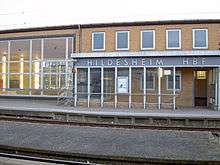Hildesheim–Brunswick railway
| Hildesheim–Brunswick | |||||||||||||||||||||||||||||||||||||||||||||||||||||||||||||||||||||||||||||||||||||||||||||||||||||||||||||||||||||||||||||||||||||||||||||||||||||||||||||||||||||||||||||||||||||||||||||||||||||||||
|---|---|---|---|---|---|---|---|---|---|---|---|---|---|---|---|---|---|---|---|---|---|---|---|---|---|---|---|---|---|---|---|---|---|---|---|---|---|---|---|---|---|---|---|---|---|---|---|---|---|---|---|---|---|---|---|---|---|---|---|---|---|---|---|---|---|---|---|---|---|---|---|---|---|---|---|---|---|---|---|---|---|---|---|---|---|---|---|---|---|---|---|---|---|---|---|---|---|---|---|---|---|---|---|---|---|---|---|---|---|---|---|---|---|---|---|---|---|---|---|---|---|---|---|---|---|---|---|---|---|---|---|---|---|---|---|---|---|---|---|---|---|---|---|---|---|---|---|---|---|---|---|---|---|---|---|---|---|---|---|---|---|---|---|---|---|---|---|---|---|---|---|---|---|---|---|---|---|---|---|---|---|---|---|---|---|---|---|---|---|---|---|---|---|---|---|---|---|---|---|---|---|
| Route number: | 313 regional 349 long distance | ||||||||||||||||||||||||||||||||||||||||||||||||||||||||||||||||||||||||||||||||||||||||||||||||||||||||||||||||||||||||||||||||||||||||||||||||||||||||||||||||||||||||||||||||||||||||||||||||||||||||
| Line number: | 1770 Nordstemmen-Hildesheim
1772 Hildesheim-Groß Gleidingen 1730 Groß Gleidungen-Brunswick | ||||||||||||||||||||||||||||||||||||||||||||||||||||||||||||||||||||||||||||||||||||||||||||||||||||||||||||||||||||||||||||||||||||||||||||||||||||||||||||||||||||||||||||||||||||||||||||||||||||||||
| Track gauge: | 1435 | ||||||||||||||||||||||||||||||||||||||||||||||||||||||||||||||||||||||||||||||||||||||||||||||||||||||||||||||||||||||||||||||||||||||||||||||||||||||||||||||||||||||||||||||||||||||||||||||||||||||||
| Voltage: | 15 kV, 16.7 Hz AC | ||||||||||||||||||||||||||||||||||||||||||||||||||||||||||||||||||||||||||||||||||||||||||||||||||||||||||||||||||||||||||||||||||||||||||||||||||||||||||||||||||||||||||||||||||||||||||||||||||||||||
| Maximum speed: | 140 | ||||||||||||||||||||||||||||||||||||||||||||||||||||||||||||||||||||||||||||||||||||||||||||||||||||||||||||||||||||||||||||||||||||||||||||||||||||||||||||||||||||||||||||||||||||||||||||||||||||||||
Legend
| |||||||||||||||||||||||||||||||||||||||||||||||||||||||||||||||||||||||||||||||||||||||||||||||||||||||||||||||||||||||||||||||||||||||||||||||||||||||||||||||||||||||||||||||||||||||||||||||||||||||||
The Hildesheim–Brunswick line is a 43 km long electrified main line railway in the German state of Lower Saxony. It forms part of the Intercity-Express route from Frankfurt to Berlin. It is also used as a diversion route from the Hanover–Brunswick line. It is a single track line from Hildesheim to Groß Gleidingen. A proposal to duplicate the line was included in the Federal Transport Infrastructure Plan of 1992.
History

The first railways were opened to Hildesheim and Brunswick in the 1840s. A direct connection across the former border between the Kingdom of Hanover and the Duchy of Brunswick was, however, not desired, at least in Hanover. East-west traffic ran through Lehrte and Kreiensen. Hildesheim was only connected via Lehrte in the north and with a branch line to Nordstemmen station on the Hanoverian Southern Railway.
After the annexation of Hanover by Prussia after the War of 1866, this situation slowly changed. The Hanover-Altenbeken Railway Company (German: Hannover-Altenbekener Eisenbahn-Gesellschaft) built the Elze–Löhne line in 1875 and connected it with the Hildesheim–Goslar line to the southeast. This meant that Hildesheim was connected to the rail network for east-west traffic. It only needed a direct connection to Brunswick to cope with increasing levels of traffic from the iron ore mines in the northern Harz district. In 1888 the approximately 35 km long link between Hildesheim to the Hanover–Brunswick line at Gross Gleidingen was put into operation.
The railway was only a secondary line. It does not lead to the major nearby city of Hanover and, until 1960, the old Brunswick station, which was built as a terminus, inhibited through traffic. From 1945, the Inner German border blocked most traffic to the east of Brunswick. With the construction of the Hanover–Würzburg high-speed line and the Hildesheim loop built to connect it to Hildesheim and Brunswick from the south, InterCity trains began to run from Frankfurt via Göttingen, Hildesheim, Brunswick and Magdeburg to Berlin in 1991. These were replaced by Intercity-Express trains in 1993 and since 1998 they have taken the route east of Brunswick via the Weddel loop and Hanover–Berlin high-speed line.
Proposed duplication
The single-track operation proved to be prone to delays. The Federal Transport Infrastructure Plan of 1992 and in its successor of 2005 provide for an upgraded line connecting Löhne, Hamelin, Hildesheim and Brunswick, including duplication. In late 2007 financing for the project was agreed, with the federal government agreeing to provide € 80 million and the state contributing € 40 million. The project would increase top speeds to 160 km/h from 140,[1] saving two minutes for long distance trains and 10 minutes for regional trains. Construction is expected to begin in summer 2009 and be finished in 2012. The total estimated cost of the project is € 138 million.[2] Work on the project began on 18 January 2010.[3][4]
References
- ↑ "Landkreis – Zweites ICE-Gleis: Baubeginn schon 2008?" (in German). Hildesheimer Allgemeine Zeitung. 18 November 2007.
- ↑ "Landkreis – Zweites ICE-Gleis 2012 fertig ." (in German). Hildesheimer Allgemeine Zeitung. 15 July 2008.
- ↑ "Niedersachsen: Baubeginn für Hildesheim – Groß Gleidingen" (in German). Eurailpress. 20 January 2010. Retrieved 6 May 2010.
- ↑ "Hildesheim–Gross Gleidingen rebuilding". Today's Railways Europe (172). April 2010.